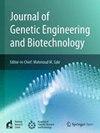Magnesium chelation of low molecular weight peptides from protein-rich industrial wastes: Production and properties
IF 2.8
Q3 Biochemistry, Genetics and Molecular Biology
Journal of Genetic Engineering and Biotechnology
Pub Date : 2025-06-25
DOI:10.1016/j.jgeb.2025.100528
引用次数: 0
Abstract
Magnesium chelating is considered a promising method to increase Mg uptake, thus fight against the prevalent case of Mg deficiency. In this study, hydrolysates and peptide fractions from spent brewer’s yeast (SBY) and soybean meal (SBM) were evaluated for the magnesium chelating ability. Despite the similar amino acid profile and protein concentration, SBY hydrolysate showed superior chelating yield than that of SBM. Cross flow filtration was shown to have facilitated the chelating process, with the specific chelating yield peaked at 94.44 mg/g protein for the 3 kDa peptide fraction of SBY hydrolysate. It was also demonstrated that at optimum conditions (pH 2 to 4 and Mg loaded 5 mM to 25 mM), the ≤ 3 kDa peptide fraction of SBY exhibited the highest magnesium chelating yield of more than 98 %. Physical and biochemistry properties of spray dried peptide chelate were also scrutinized. The FTIR spectra confirmed the chelating sites of peptide were amino and carboxyl groups; and the particle size distribution of Mg chelated peptides was identified in the range of 1000 nm. Our findings concerning the in-vitro gastrointestinal stability and cytotoxicity have confirmed the suitability of magnesium chelated SBY for animal and human consumption.
从富含蛋白质的工业废料中提取低分子量肽的镁螯合:生产和性能
镁螯合被认为是一种很有前途的方法来增加镁的摄取,从而对抗普遍存在的镁缺乏症。本研究以废啤酒酵母(SBY)和豆粕(SBM)的水解产物和肽组分为研究对象,对其镁的螯合能力进行了评价。尽管氨基酸谱和蛋白质浓度相似,但SBY水解产物的螯合产量优于SBM。交叉流过滤被证明促进了螯合过程,对于SBY水解物的3kda肽部分,其特定螯合产率达到94.44 mg/g蛋白。结果表明,在最佳条件下(pH 2 ~ 4, Mg负载5 ~ 25 mM),≤3 kDa肽段的SBY螯合率最高,可达98%以上。并对喷雾干燥肽螯合物的物理生化特性进行了研究。FTIR光谱证实肽的螯合位点为氨基和羧基;在1000 nm范围内确定了Mg螯合肽的粒径分布。我们关于体外胃肠道稳定性和细胞毒性的研究结果证实了镁螯合SBY的动物和人类食用的适用性。
本文章由计算机程序翻译,如有差异,请以英文原文为准。
求助全文
约1分钟内获得全文
求助全文
来源期刊

Journal of Genetic Engineering and Biotechnology
Biochemistry, Genetics and Molecular Biology-Biotechnology
CiteScore
5.70
自引率
5.70%
发文量
159
审稿时长
16 weeks
期刊介绍:
Journal of genetic engineering and biotechnology is devoted to rapid publication of full-length research papers that leads to significant contribution in advancing knowledge in genetic engineering and biotechnology and provide novel perspectives in this research area. JGEB includes all major themes related to genetic engineering and recombinant DNA. The area of interest of JGEB includes but not restricted to: •Plant genetics •Animal genetics •Bacterial enzymes •Agricultural Biotechnology, •Biochemistry, •Biophysics, •Bioinformatics, •Environmental Biotechnology, •Industrial Biotechnology, •Microbial biotechnology, •Medical Biotechnology, •Bioenergy, Biosafety, •Biosecurity, •Bioethics, •GMOS, •Genomic, •Proteomic JGEB accepts
 求助内容:
求助内容: 应助结果提醒方式:
应助结果提醒方式:


